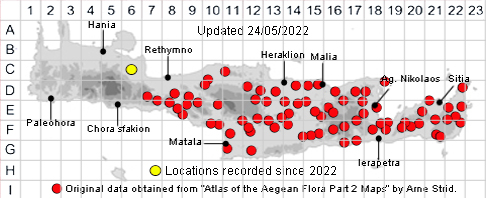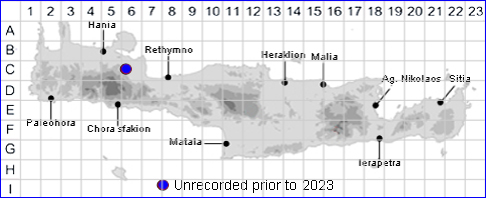
SPECIES DESCRIPTION
IRIS UNGUICULARIS subsp. CRETENSIS
Including Iris unguicularis subsp. carica
Family and Genus:- See- IRIDACEAE/Subgen. IRIS/Sect. SPATHULA
Common Names:- Cretan iris
Homotypic Synonyms:- Iris cretensis, Iris humilis subsp. cretensis,
Siphonostylis cretensis.
Meaning:- Iris (L) After Iris, the mythological messenger of the gods of the
rainbow.
Unguicularis (L) With a small claw.
Cretensis (L) Cretan, from Crete.
General description:- Rhizomatous herb with tough branched rhizome and wiry
roots, forming dense, grass-like clumps.
Stems:-
1) Very short or absent.
2) Dead leaves persistent, pale brown, eventually detaching in their entirety and
not leaving fibrous bases.
Leaves:-
1) Blade,10-50 cm x 1-5 mm, tough, strap-shaped, flexuous, pointed, deep green.
Flowers:-
1) Solitary, fragrant.
2) Pedicel, short.
3) Spathes, 60-130 mm, mainly herbaceous.
4) Falls, oblong to narrowly oblanceolate, usually <55 mm, deep, violet or reddish-
lavender in apical 1/4 only, rest of blade white with prominent violet veins and a
broad orange-yellow median stripe.
5) Standards, 45-55 x 7-10 mm, suberect, somewhat smaller than the falls, broadly
spathulate, lilac.
6) Hypanthial tube, 60-200 mm, very slender.
7) Style-branches, yellow-glandular-puberulent above near the margins.
Fruit:-
1) Seeds, few, c. 5 mm, globose to ovoid, rugose, orange-brown.
Key features:-
1) Falls, usually <55 mm, deep.
Habitat:- Dry sunny habitats, rocky places, banks, open scrub, rock ledges. 0-700
(-1900) m.
Distribution:- Endemic to Crete and Karpathos. Widespread and common on
Crete, most of Crete, lacking in the west.
Flowering time:- (Jan-)Feb to Apr.
Photos by:- Steve Lenton

IRIS UNGUICULARIS subsp. CARICA
Common Names:- None
Homotypic Synonyms:- Iris unguicularis var. carica, Siphonostylis carica,
Siphonostylis cretensis subsp. carica.
Meaning:- Carica (L) From Carica (this epithet probably comes from Caria in
southwest Anatolia (Asia Minor), Turkey.
Resembling subsp. cretensis, but differering in the following characters.
1) Falls:
a) usually >55 mm.
b) oblanceolate.
c) lavender blue with a rather narrow yellow stripe along lower part of the midvein
and white lateral stripes extending halfway to the margin.
Habitat:- As for subsp. cretensis
Distribution:- Greece, mainly in coastal areas northwards to 40°N; SW Anatolia,
W Syria and Lebanon.
Previously unrecorded from Crete. Discovered by Manolis Petakakis near Agii
Pantes. January 2023.
Flowering time:-As for subsp. cretensis
Photos by:- Manolis Petakakis & Christopher Cheiladakis
